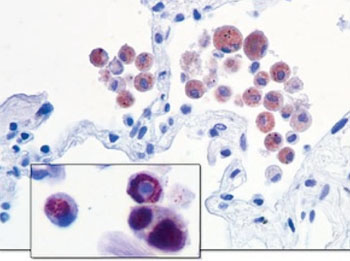Novel Method Prepares Tissue Samples for Analyzing Proteins
By LabMedica International staff writers
Posted on 23 Apr 2014
A new way of preparing patient tissue for analyses might soon become the new standard, possibly replacing tissues fixed with formalin, before they are embedded in wax-like paraffin and cut into razor-thin slices.Posted on 23 Apr 2014
The new method allows tissue samples to be treated such that they do not only meet the requirements of clinical histology, but can still be characterized later on by modern methods of proteomics, a technique analyzing all proteins at once.

Image: Immunostaining of human lung tissue, fixed with HOPE, from a patients suffering from legionnaire\'s disease. One legionella protein (red-brown), the bacteria-containing vacuoles and individual legionella inside the scavenger cells can be detected. The infection process can be observed immediately using proteomics (Photo courtesy of Braunschweig University of Technology).
Scientists at the Helmholtz Center for Infection Research (Braunschweig, Germany) obtained lung tissue samples from surgery patients. From each donor one piece of lung tissue was immediately frozen in liquid nitrogen and the other piece was fixed using the Hepes-glutamic acid buffer mediated Organic solvent Protection Effect or HOPE technique (DCS Diagnostics; Hamburg, Germany).
For proteomic analyses the HOPE fixed and snap frozen lung samples were homogenized, sonicated, and centrifuged. After estimating protein content, the proteins were digested and phosphopeptide enriched. The peptides were analyzed on an UltiMate 3000 RSLC nano LC system connected to an LTQ Orbitrap Velos Pro mass spectrometer (Thermo Scientific, Waltham, MA, USA).
The team found that in contrast to snap-frozen samples, HOPE fixation preserves the structure of tissues well and for example lung vesicles can be seen more clearly. They used mass spectrometry in order to characterize the proteins that are present in the tissue. The proteome derived from this study tells much about the health status of the tissue. The scientists went one step further and also investigated the so-called phosphoproteome which is all protein molecules in the cell that are currently switched on or off. To know which proteins are active contributes to the diagnosis of diseases and can help identify targets for new medications. The results are very promising: HOPE fixation does not only preserve the structure of the tissue but is just as well-suited for proteomics and phosphoproteomics as snap-freezing the tissue.
Lothar Jänsch, PhD, a professor and the senior author of the study said, “Based on our results, we recommend HOPE as the fixation strategy for clinics and biobanks that are actively involved in improving diagnosis and therapies.” The team of investigators applied this novel method also to studies on legionnaire's disease, an infectious disease that is caused by bacteria and is associated with pneumonia. The authors recommend HOPE generally as the “fixative of choice” for studies aiming to describe molecular features of human tissues at the systems level. HOPE fixation opens promising avenues for a better understanding of human diseases and best matches perspective requirements for personalized clinical analytics. The study was published on April 7, 2014, in the Journal of Proteome Research.
Related Links:
Helmholtz Centre for Infection Research
DCS Diagnostics
Thermo Scientific














